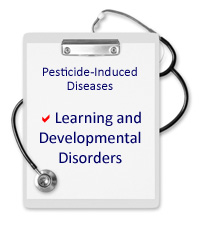02
Feb
Commonly Used Pyrethroid Pesticide Increases Risk of ADHD
(Beyond Pesticides, February 2, 2015) A study led by a Rutgers University research team finds that the commonly used pesticide deltamethrin increases the risk of attention deficit hyperactivity disorder (ADHD) in children, adding to a mounting body of scientific research linking pesticide exposure to the disorder. Rutgers scientists, along with colleagues from Emory University, the University of Rochester Medical Center, and Wake Forest University discovered that mice exposed to the pyrethroid insecticide deltamethrin in utero and through lactation exhibit several features of ADHD, including dysfunctional dopamine signaling in the brain, hyperactivity, working memory, attention deficits and impulsive-like behavior. The study, Developmental pesticide exposure reproduces features of attention deficit hyperactivity disorder, was published Wednesday in the Journal of the Federation of American Societies for Experimental Biology (FASEB).
ADHD is estimated to affect 8—12% of school-age children worldwide. ADHD is a complex disorder, and though is strong scientific evidence that genetics play a role in susceptibility to the disorder, no specific gene has been found that causes ADHD and scientists believe that environmental factors, such as pesticide exposure, may contribute to the development of the behavioral condition.
“Although we can’t change genetic susceptibility to ADHD, there may be modifiable environmental factors, including exposures to pesticides that we should be examining in more detail,” says lead author Jason Richardson, Ph.D., associate professor in the Department and Environmental and Occupational Medicine at Rutgers Robert Wood Johnson Medical School and a member of the Environmental and Occupational Health Sciences Institute (EOHSI).
Using data from the Centers for Disease Control, National Health and Nutrition Examination Survey (NHANES), the study analyzed health care questionnaires and urine samples of 2,123 children and adolescents. Researchers asked parents whether a physician had ever diagnosed their child with ADHD and cross-referenced each child’s prescription drug history to determine if any of the most common ADHD medications had been prescribed. Children with higher pyrethroid pesticide metabolite levels in their urine were more than twice as likely to be diagnosed with ADHD.
Deltamethrin is commonly used in the home, and on vegetable crops, gardens, lawns and golf courses. As part of the chemical class of synthetic pyrethroids, it is often touted as a safer alternative to other pesticides, or deemed “as safe as chrysanthemum flowers” by pest control companies. However, there are many recent studies that show significant concern with this class of chemicals. In addition to this new study, pyrethroids have previously been linked to learning problems, and adverse behavioral and emotional development in children.
The prolific use of these chemicals means that exposure to these chemicals is widespread. Recent research has found that residents of New York City are more highly exposed to organophosphates and pyrethroid pesticides than the average American, and another 2008 survey found pyrethroid contamination in 100 percent of urban streams sampled in California. Despite new data on concerning health affects to children, in 2012 EPA expanded the allowed uses of these pesticides and removed an additional protective safety factor for children.
ADHD most often affects children, with an estimated 11 percent of children between the ages of 4-17 —about 6.4 million, diagnosed as of 2011. Boys are three to four times more likely to be diagnosed than girls. Notably, researchers in this study observed that male mice were affected more than the female mice. The ADHD-like behaviors persisted in the mice through adulthood, even when the pesticide was no longer detected in their system.
Young children and pregnant women may be more susceptible to pesticide exposure because their bodies do not metabolize the chemicals as quickly. According to Dr. Richardson, this is why human studies need to be conducted to determine how exposure affects the developing fetus and young children.
With the mounting evidence of the impacts of pesticides to human health, the success of management approaches that do not rely on hazardous pesticides, demonstrates that exposure to these pesticides are unnecessary. Beyond Pesticides has many resources, including the ManageSafe database to help avoid and manage unwanted insects without the use of synthetic chemicals. These techniques include exclusion, sanitation and maintenance practices, as well as mechanical and least-toxic controls (which include boric acid and diatomaceous earth).
For more information on the hazards of pesticides and human health, visit Beyond Pesticides’ Pesticide-Induced Diseases Database, where we track the science on how pesticides are contributing to the rise of learning and developmental disorders in children, and see our factsheet, Children and Pesticides Don’t Mix.
Sources: Science Daily, The Federation of American Societies for Experimental Biology Journal
All unattributed positions and opinions in this piece are those of Beyond Pesticides.










